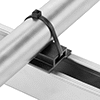Filter by
Rail Height
Material
Color
T-Slotted Framing Component
Bracket Type
Finish
DFARS Specialty Metals
Strut Channel Type
Rail Width
Single Rail Profile Style
Framing Type
Strut Channel Framing Component
T-Slotted Framing Nut Type
Most Likely Products
All Results
Containers, Storage, and Furniture
Building and Machinery Hardware
Measuring and Inspecting
Fastening and Joining
Electrical
Material Handling

























































































































































